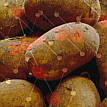Material
Biopolymers

They can be produced by biological systems (i.e. micro-organisms, plants and animals), or chemically synthesized from biological starting materials (e.g. sugars, starch, natural fats or oils, etc.).
Biopolymers are an alternative to petroleum-based polymers (traditional plastics).
(Bio)polyesters have properties similar to traditional polyesters.
Starch-based polymers are often a blend of starch and other plastics (e.g PE), which allows for enhanced environmental properties.
Polyesters| Biopolymer type | Price (DKK/kg) | Density (kg/liter) |
| Aliphatic-aromatic copolymer | - | - |
| Aliphatic polyesters | - | - |
| CPLA | 25-50 | 1.25 |
| PCL | - | - |
| PHA | 15-60 | 1.25 |
| PLA | 30-70 | 1.26 |
Starch-based polymers| Biopolymer type | Price (DKK/kg) | Density (kg/liter) |
| 10 % Starch | - | - |
| 50 % Starch | - | - |
| 90 % Starch | 20-40 | - |
| Foamed starch | - | - |
Others| Biopolymer type | Price (DKK/kg) | Density (kg/liter) |
| Casein formaldehyde | - | 1.33 |
| Celluose acetate | - | - |
| Horn | - | - |
Environ-
mentals notesBiodegradability and other plastic properties strongly depend on the polymer structure. By changing the structure, these properties can be altered.
PriceThe price of biopolymers is still fairly high compared to oil-based polymers. This is due to lower production-volumes than petroleum-based polymers.
However, the growing environmental consciousness and the application of life-cycle evaluations in the material circuit may help biomass-based raw materials to become mass-produced and cheaper, replacing traditional plastics in a number of applications.
Significant price reductions can be expected within the next two years.
ReferencesLinks:
Biodegradable Polymers and Plastics in Japan
Biofibre.net
Biopolymer.net
DTI, Centre for Product Development
GBF - Enviromental Biochemical Engineering
Proterra - Int. Centre for Agro-based Materials
How green are green plastics?
Companies:
Biotec GmbH
National Starch & Chemical
Books, Magazines & Papers:
Biopolymers (journal)
Biopolymers (paper)
Photo
Copyright© 1996-2019 Torben Lenau
This page is part of Design
inSite
Disclaimer